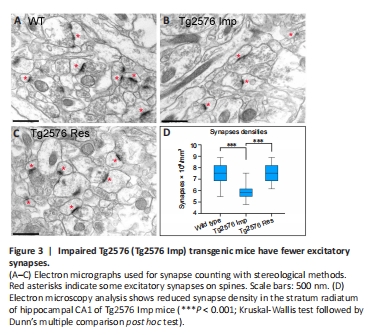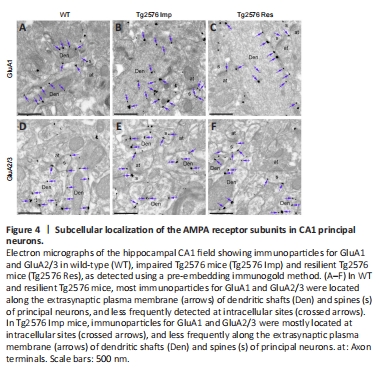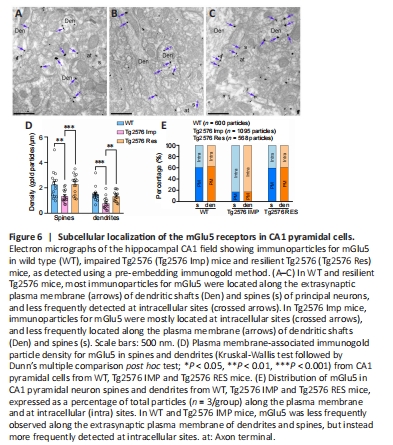神经退行性病
-
Figure 3|Impaired Tg2576 (Tg2576 Imp) transgenic mice have fewer excitatory synapses.

The quantification of excitatory synapses was performed in the neuropil, excluding neuronal and glial somata, blood vessels, apical dendrites, and myelinated axons. This provided us with a comprehensive understanding of the synaptic organization in the CA1 field and the rate of connectivity. The density of excitatory synapses was determined (Figure 3A–D). Statistical analysis demonstrated a significant difference between wild-type and impaired Tg2576 mice (Kruskal-Wallis test followed by Dunn’s multiple comparison post hoc; P < 0.001), as well as between impaired Tg2576 and resilient Tg2576 mice (Kruskal-Wallis test followed by Dunn’s multiple comparison post hoc; P < 0.001). However, no significant difference was observed between wild-type and resilient Tg2576 mice (P > 0.05), indicating a 20% decrease in the number of synapses per volume in the impaired Tg2576 mice (Figure 3D). This data reveals important insights into the alterations in synaptic density and connectivity patterns in the context of cognitive impairment and resilience, contributing to a deeper understanding of the synaptic changes associated with Tg2576 mice.
Figure 4|Subcellular localization of the AMPA receptor subunits in CA1 principal neurons.

In the next step, we utilized pre-embedding immunoelectron microscopic approaches in the CA1 stratum radiatum to investigate whether aged Tg2576 mice exhibit evidence of AD-linked dysregulation of AMPA receptors. These receptors have been known to undergo alterations in response to exposure to Aβ, as previously demonstrated in ultrastructural studies on other animal models of AD (Kamenetz et al., 2003; Martín-Belmonte et al., 2020b; Alfaro-Ruiz et al., 2022). To assess whether Aβ leads to a similar redistribution of GluA1 and GluA2/3 subunits in cognitive impaired Tg2576 and resilient Tg2576 mice, we conducted quantitative pre-embedding immunoelectron microscopy in the hippocampus from the CA1 stratum radiatum. In wild-type mice, GluA1 and GluA2/3 immunoreactivity was detected along the extrasynaptic plasma membrane in spines and shafts of CA1 pyramidal cells, as well as at intracellular sites (Figure 4A and D). In impaired Tg2576 mice, immunoparticles for GluA1 and GluA2/3 were more frequently detected intracellularly (Figure 4B and E). However, in resilient Tg2576 mice, the distribution of the two AMPA receptor subunits increased along the plasma membrane (Figure 4C and F).
Figure 6|Subcellular localization of the mGlu5 receptors in CA1 pyramidal cells.

A previous study has revealed a decrease in the density of mGlu5 receptors in dendritic spines and dendritic shafts of CA1 pyramidal cells in APP/PS1 mice (Martín-Belmonte et al., 2021). To expand on this, our next set of analyses aimed to compare the subcellular localization of mGlu5 receptors associated with excitatory synapses in three groups: wild type, impaired Tg2576, and resilient Tg2576 mice. In wild-type mice, mGlu5 immunoparticles were detected to be present in the extrasynaptic plasma membrane of spines and shafts of CA1 pyramidal cells and were also associated with intracellular sites within the same neuronal compartments (Figure 6A). In impaired Tg2576 mice, we observed a significant reduction in the density of mGlu5 immunoparticles in dendritic compartments (P < 0.001 for spines and dendrites, Kruskal-Wallis test) compared with wild-type mice (Figure 6B and D). This decrease in plasma membrane localization was accompanied by an increase in cytoplasmic localization (Figure 6E). Conversely, in resilient Tg2576 mice, the density of mGlu5 immunoparticles was found to be similar to that of wild-type mice (Dunn’s multiple comparison post hoc; Figure 6C and D). Additionally, the percentage of mGlu5 immunoparticles along the plasma membrane and at cytoplasmic sites was also comparable to wild-type mice (Figure 6E). In summary, the amount of mGlu5 receptors in resilient mice was maintained at wild-type levels but was increased compared with cognitive impaired mice.